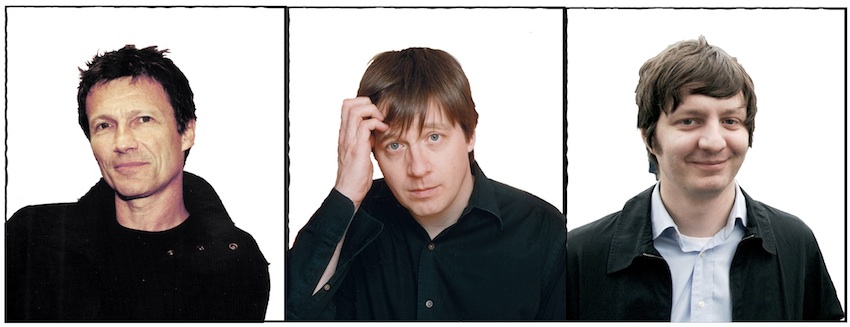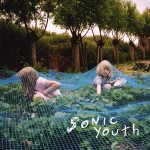
While we won’t be covering the upstate edition of All Tomorrow’s Parties this weekend, self-titled recently tracked down Aaron Mullan (one of the two founding guitarists/vocalists in Tall Firs) to talk about his work with two ATP performers: Michael Rother‘s Hallogallo trio–a modern take on the guitarist’s solo material and classic Neu!/Harmonia songs–and his longtime employers Sonic Youth. Mullan was actually at the latter’s Hoboken studio when we called. He’ll be playing bass with Hallogallo on Saturday night at the main ATP stage.
“It’s fun to be onstage with the only guy who can do that”
So what’s the deal with this studio?
Sonic Youth shares it with some other people. We work there weekdays–from 9 to 5 basically–and the other guys do weekends and nights.
What are you working on right now then?
At this very moment, we’re in the middle of a couple things, including some archival releases. There’s live [Sonic Youth] cassettes going all the way back to 1981, so there’s a lot to go through all the time.
And Tall Firs are still working on a new album right?
Yeah, we’re working on the third album. Some of the production’s moved to my basement because it’s nice to go home, cook dinner, and be a normal person for a few hours a day versus calling your wife and saying, “Okay, I’ll see you at 2 in the morning” or whatever.
Well at least you have an alibi.
Exactly. She knows where I am and can monitor how much beer we’re bringing down to the basement.
So are you a part of this Hallogallo thing partially because of your work with Sonic Youth? Did Steve suggest you?
No, I actually do sound for All Tomorrow’s Parties in the UK. I’m the ringer who does a lot of the live sound engineering. Even if I don’t know a band, I usually know their top five records, which helps a lot. Anyway, when Harmonia was playing, I went and talked to them beforehand. Since I’m a total fan of theirs, I was asking Michael stuff like, “So were you on that Kraftwerk bootleg from 1971?” And he was just like, “What? Who are you?” But then they invited me to come hang out later, so I ended up finding them at 2 in the morning, drinking straight vodka.
When they came to New York for ATP, I told Michael he should come down to the Sonic [Youth] studio and do some recording. Steve was around, so it was like, “Well, do you want to play too? I can play bass.” The next thing you know, here we are–playing these shows.
So it really was that organic?
Yeah, it was all about meeting people who are fun to hang out with basically.
When you first started hanging out, was Michael already talking about revisiting some of Neu!’s material, or was he thinking about sticking to Harmonia stuff?
When I first met him, the Neu! box set was in the works, but I don’t think he was intending to do a live version yet.
Since you’re a fan, do you have a specific album or project of his that you prefer?
I don’t know. I’ve gone through phases. A lot of my friends are into Harmonia, so that was the constant hangout record for a while. The first two Neu! records have also always spoken to me. I didn’t know about [Michael’s] solo records until recently, though. A lot of people come up to him and gush about how the first one (Flammende Herzen) was their favorite guitar record of all time.
Now that you’re accustomed to the solo material, is there an album you’d recommend?
Probably the first one, and you can go chronologically from there.
You’ve sat in with a lot of bands before, so how would you describe performing with Michael?
I don’t know. I’ll tell a story to try and explain it. Tall Firs was playing a show with some friends of ours one night and they had Brendan Canty (of Fugazi) playing drums. It was right around the end of the Knitting Factory–the Manhattan one–and Brendan had to borrow our drummer’s snare drum. I just remember hearing that snare and recognizing it as Brendan’s playing right away. It’s the same way with Michael. There’s no way you could confuse him with anyone else. It doesn’t matter if he has his pedals or his guitar. It’s all in his hands–his touch. So it’s fun to be onstage with that guy–the only guy who can do that.
There’s definitely a specific tone to what he’s doing that’s immediately recognizable.
So much of that comes from him, not the equipment, though. He’s almost like the Edge (from U2) in a way, although the Edge has way more repeats on his delay than Michael. [Laughs]
Is your stage setup a little nerve-wracking? It seems like it would be, especially since Michael’s using a laptop for some of the sounds…
I’m not stressed out. I guess there’s the element of samples going on, but whether they’re perfectly balanced or not? That’s what a record’s for. It’s not going to be totally seamless onstage. I like watching musicians perform together, and react to one another in the moment, you know?
Is that how you’d describe a lot of the live songs–as you guys feeding off of one another?
I think so. I’m often playing one note for the whole song, but it’s all about the rhythm for me. I’m changing that up and the timbre of what I’m playing–the dynamics…A lot of what’s great about Sonic Youth is that they’re into the physical being of the instrument and using your ears instead of thinking about what note your playing. It’s just a different approach. They don’t know what note they’re playing half the time, or the key they’re in. It’s all about moving your hands to wherever the music sounds the best.
Is Michael’s music kinda the polar opposite of that, though?
Well, I know what note I’m playing because it’s usually just one. [Laughs] But to me, it’s the same thing. It’s dealing with the physical instrument and doing the simplest things–even just changing the angle that I hold the pick at can mean a lot.
Have you and Steve played in any Sonic Youth side projects before?
Not previous to this, actually. We goof around sometimes during Sonic Youth’s sound checks, but that’s about it. He’s started playing with this band Spectre Folk, though–these guys Pete Nolan (of Magik Markers) and Peter Meehan. And I’ve recorded some sessions for them. Yeah, it’s weird to finally be playing music together after eight or nine years of working together.
So you’ve basically been Sonic Youth’s sixth man for a while now, then?
Yeah, I’ve been doing that since January of 2000.
When did you first meet them then?
I met Thurston and Kim in ’96. I went to Hampshire College and he came over to do some recording. It was the weirdest thing in the world to me because I’m the biggest Sonic Youth fan and it was like, “What? Thurston’s at my college making a record This is so crazy?” And Kim was around since they were in the process of moving there.
My wife and I moved to Brooklyn in ’98, and I worked at Tonic, so I met Lee [Ranaldo] and Steve when they were performing with their side projects. My wife also worked at Steve’s label for a little while, so it all fell together.
What did you do at Tonic?
I was the first sound engineer hired by the club. I was only there for a year and a half, until the Sonic Youth stuff started picking up.
And Tall Firs?
We started working on the first record in 2001, although we’d played together since the early ’90s.
Yeah, I wasn’t sure if that was true or not.
Oh, it’s true. Ridiculous, but true.
So you just fucked around throughout the ’90s and then suddenly decided to start a band a decade later?
We tried to have bands in the ’90s but we could never find a drummer.
Well, you have a solid drummer now (Ryan Sawyer). How’s that new material sounding then?
It’s halfway done. We’ve also got this other band we joined called Glass Rock. We had an album come out last year on Ecstatic Peace, and are halfway through the next one now, too. Unless something magical happens, neither of them will be out this year.
How much time did you have to rehearse with Michael for these shows?
We went to Germany in May for four days of rehearsals, and then did some of our first shows. A lot of preparation goes into each song. Every day is a new adventure. I hesitate to predict what will happen next, actually. [Laughs]
